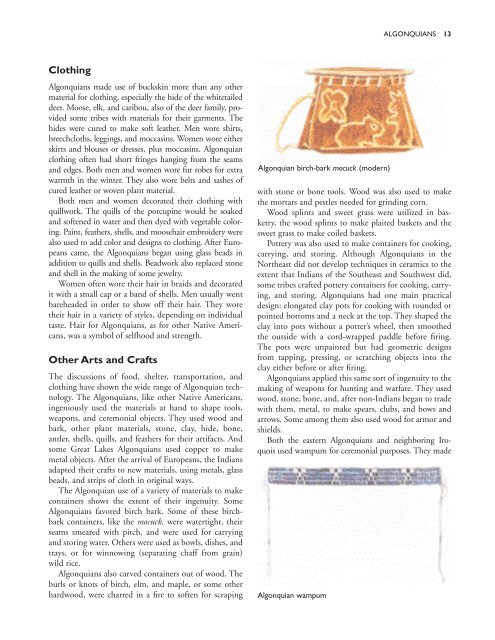Create successful ePaper yourself
Turn your PDF publications into a flip-book with our unique Google optimized e-Paper software.
ALGONQUIANS 13<br />
Clothing<br />
Algonquians made use <strong>of</strong> buckskin more than any other<br />
material for clothing, especially the hide <strong>of</strong> the whitetailed<br />
deer. Moose, elk, and caribou, also <strong>of</strong> the deer family, provided<br />
some tribes with materials for their garments. The<br />
hides were cured to make s<strong>of</strong>t leather. Men wore shirts,<br />
breechcloths, leggings, and moccasins. Women wore either<br />
skirts and blouses or dresses, plus moccasins. Algonquian<br />
clothing <strong>of</strong>ten had short fringes hanging from the seams<br />
and edges. Both men and women wore fur robes for extra<br />
warmth in the winter. They also wore belts and sashes <strong>of</strong><br />
cured leather or woven plant material.<br />
Both men and women decorated their clothing with<br />
quillwork. The quills <strong>of</strong> the porcupine would be soaked<br />
and s<strong>of</strong>tened in water and then dyed with vegetable coloring.<br />
Paint, feathers, shells, and moosehair embroidery were<br />
also used to add color and designs to clothing. After Europeans<br />
came, the Algonquians began using glass beads in<br />
addition to quills and shells. Beadwork also replaced stone<br />
and shell in the making <strong>of</strong> some jewelry.<br />
Women <strong>of</strong>ten wore their hair in braids and decorated<br />
it with a small cap or a band <strong>of</strong> shells. Men usually went<br />
bareheaded in order to show <strong>of</strong>f their hair. They wore<br />
their hair in a variety <strong>of</strong> styles, depending on individual<br />
taste. Hair for Algonquians, as for other <strong>Native</strong> <strong>American</strong>s,<br />
was a symbol <strong>of</strong> selfhood and strength.<br />
Other Arts and Crafts<br />
The discussions <strong>of</strong> food, shelter, transportation, and<br />
clothing have shown the wide range <strong>of</strong> Algonquian technology.<br />
The Algonquians, like other <strong>Native</strong> <strong>American</strong>s,<br />
ingeniously used the materials at hand to shape tools,<br />
weapons, and ceremonial objects. They used wood and<br />
bark, other plant materials, stone, clay, hide, bone,<br />
antler, shells, quills, and feathers for their artifacts. And<br />
some Great Lakes Algonquians used copper to make<br />
metal objects. After the arrival <strong>of</strong> Europeans, the Indians<br />
adapted their crafts to new materials, using metals, glass<br />
beads, and strips <strong>of</strong> cloth in original ways.<br />
The Algonquian use <strong>of</strong> a variety <strong>of</strong> materials to make<br />
containers shows the extent <strong>of</strong> their ingenuity. Some<br />
Algonquians favored birch bark. Some <strong>of</strong> these birchbark<br />
containers, like the mocuck, were watertight, their<br />
seams smeared with pitch, and were used for carrying<br />
and storing water. Others were used as bowls, dishes, and<br />
trays, or for winnowing (separating chaff from grain)<br />
wild rice.<br />
Algonquians also carved containers out <strong>of</strong> wood. The<br />
burls or knots <strong>of</strong> birch, elm, and maple, or some other<br />
hardwood, were charred in a fire to s<strong>of</strong>ten for scraping<br />
Algonquian birch-bark mocuck (modern)<br />
with stone or bone tools. Wood was also used to make<br />
the mortars and pestles needed for grinding corn.<br />
Wood splints and sweet grass were utilized in basketry,<br />
the wood splints to make plaited baskets and the<br />
sweet grass to make coiled baskets.<br />
Pottery was also used to make containers for cooking,<br />
carrying, and storing. Although Algonquians in the<br />
Northeast did not develop techniques in ceramics to the<br />
extent that Indians <strong>of</strong> the Southeast and Southwest did,<br />
some tribes crafted pottery containers for cooking, carrying,<br />
and storing. Algonquians had one main practical<br />
design: elongated clay pots for cooking with rounded or<br />
pointed bottoms and a neck at the top. They shaped the<br />
clay into pots without a potter’s wheel, then smoothed<br />
the outside with a cord-wrapped paddle before firing.<br />
The pots were unpainted but had geometric designs<br />
from tapping, pressing, or scratching objects into the<br />
clay either before or after firing.<br />
Algonquians applied this same sort <strong>of</strong> ingenuity to the<br />
making <strong>of</strong> weapons for hunting and warfare. They used<br />
wood, stone, bone, and, after non-Indians began to trade<br />
with them, metal, to make spears, clubs, and bows and<br />
arrows. Some among them also used wood for armor and<br />
shields.<br />
Both the eastern Algonquians and neighboring Iroquois<br />
used wampum for ceremonial purposes. They made<br />
Algonquian wampum


















